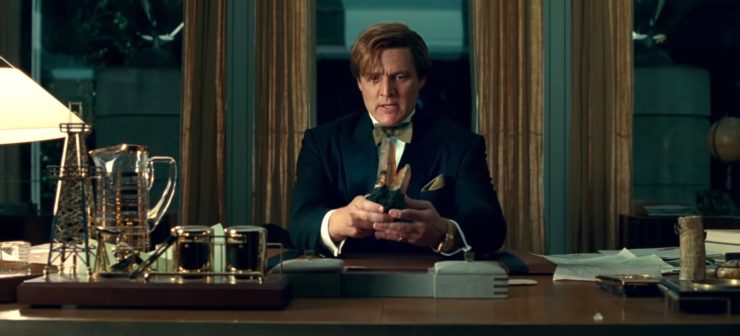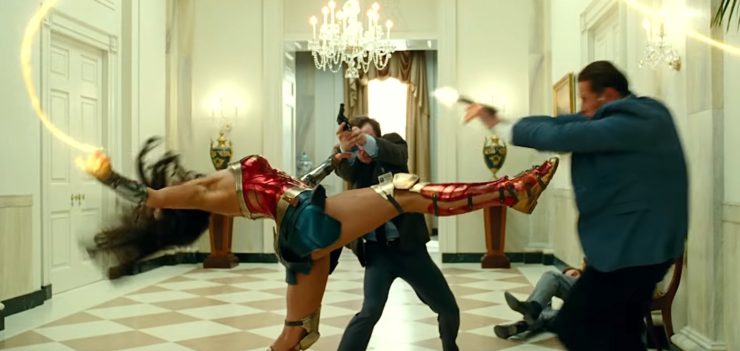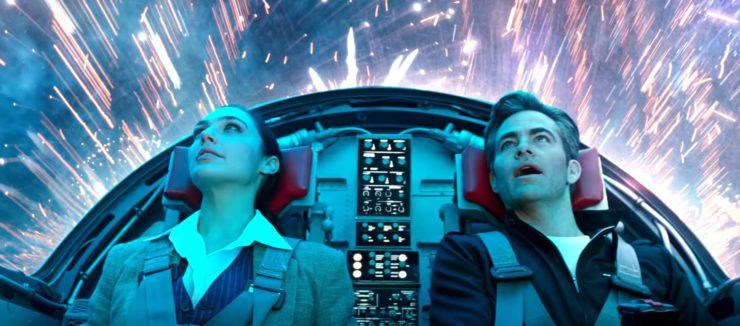Sometimes you watch a film, and it feels as though you’re having a conversation that never quite makes it to the point. You can see the threads, the ideas, the potential of the discussion you’re making your way toward, but you never arrive. Wonder Woman 1984 is a lot like that—an experience packed to the brim with potential, thoughts, even fun… that just can’t seem to find its way home.
(Some spoilers for WW1984.)
The greatest error of the sequel to 2017’s Wonder Woman is that it’s far too long. Most of the enjoyment in the film can be found in its interpersonal dynamics, but those are quickly subsumed by world-ending action, global chaos, and scenery-chewing villainy. Superhero films, especially ones made using characters owned by reigning titans Marvel and DC Comics, have forgotten that sometimes the greatest stories have the smallest footprints. With Wonder Woman, who has extra weight heaped onto her shoulders for being one of the only female superheroes with her own series of films, the burden is greater—the need to prove that Diana can save the entire world just as well as Superman is writ large over everything she does.
It’s a shame because WW1984 had the ability to tackle some dearly important themes for our time. The film centers around a stone that grants a single wish to anyone who touches it—but those wishes come at a price because they’re being granted by a trickster god-imbued object. Where the first Wonder Woman movie had Diana showdown against the god of war, this story wishes to see her lasso of truth pitted against an artifact left behind by a god of lies. The idea is a sound one, and a sharp reflection of our own post-truth, conspiracy-laden world, if only the story were willing to take us there. Instead, we get too caught up in a sudden globe-trotting interlude and an overwrought, meandering focus on one of the film’s villains, Pedro Pascal’s Max Lord. While Pascal is clearly having a ball chewing scenery as a hopeful con man who makes the mistake of wishing to become the wishing stone itself, the film is weighted heavily toward his perspective to seemingly no purpose… until the movie decides to dump a boatload of Lord’s rote backstory onto the audience in its final minutes.

This sadly means that we miss out on the villain with whom Diana (Gal Gadot) has all the chemistry and screen time: Barbara Minerva (Kristen Wiig), better known in the comics as Cheetah. Wonder Woman has always been known for a hefty seasoning of homoerotic tension when set against female antagonists, and it’s no different here—a meet cute at the Smithsonian were they both work, an awkward invitation to lunch that eventually becomes dinner, Barbara’s desire to be just like Diana. But when Barbara imparts a wish to become as sexy and strong as her new coworker, she doesn’t realize that wishing on the stone will work, or come at the price of her empathy.
It seems ridiculous that the film couldn’t have leaned into the queerness of this dynamic rather than shying away from it entirely; for one, Diana has been confirmed bisexual for a while (and arguably was since her conception), and allowing Barbara the same would mitigate some of that aggravating woman-on-woman jealousy that we don’t really need to see, just, ever. Even the narrative seems aware of its own fallacy in this regard, on more than one level—after Barbara makes her wish, she immediately gets “sexier” when she wakes up at work the next day by making two adjustments to her wardrobe. It turned out that the only thing standing in Barbara Minerva’s way to “hotness” was an oddly placed barrette and an unfortunate skirt. In moments like this, the film’s own self-awareness should be a welcome reprieve, a place to sigh in relief. But because Barbara never comes to that realization herself, that self-awareness rings hollow.
The fact of the matter is that the film isn’t comfortable with more complex ideas of being in the world, and that frequently brings it low when it could have built a far more interesting narrative. Max Lord’s rushed backstory is as clichéd as they come and never addressed in any detail, particularly in how it plays through to his relationship with his own young son. Barbara Minerva’s turn toward villainy comes in a moment when she chooses to confront a man who tried to sexually assault her in the first half hour of the film, and the audience is clearly not meant to side with her because she’s choosing violence—since that is at odds with our protagonist’s mantra of choosing love and peace. Diana herself is apparently struggling as well because she misses Steve Trevor, to the point where she nearly takes the trade-off of her own wish—losing her powers—to have him back in her life.
At the center of this baffling error is the film’s setting in the 1980s, an era that was perfectly poised to take the weight off of this issue in our hero’s arc. It would have been far more effecting to have simply suggested that Diana was having a rough go in the 80s; despite how much fun making nostalgic movies can be, it’s more likely that Diana would have had difficulty in the “decade of excess” as it is often known. Most of what was lauded in that period goes against the Wonder Woman ethos, and the idea that Diana would have been exhausted to see society taking such a visible turn toward artifice and hyper-consumerism makes sense. The idea that she would miss Steve Trevor more in the wake of that change makes sense as well. A lot more sense than the idea that she’s been pining over a dead man for sixty flipping years.
And that would have given Steve (still played with radical maximum softness by Chris Pine) leave to be every bit as charming and wide-eyed and lovely as he is throughout the film, but with the added emotional resonance his return deserves. Because it’s fine to say that his place in the movie is ultimately about being there to remind Diana to let herself participate in the world in a general sense, but it would have been far more beautiful to create a story where he magically arrived at that single moment in time that she needed him most, in a complete reversal of the sort of tropes typically unloaded onto women for the sake of male hero stories. Steve and Diana’s scenes make up most of the best parts of the film, and they are rapturous and delightful, but they’re marred by the broadness of the film’s storytelling choices, it’s lack of specificity.
There’s also a consent issue here that is frankly shocking, being the fact that Steve has been brought back by using someone else’s body. Which… why? If the stone is capable of bringing him back at all and creating objects out of nothing (which it can), this conceit makes no sense, and then becomes a point of negligence on Diana’s part. Effectively, she sleeps with someone else’s body without their knowledge. Additionally, if she were to keep Steve alive, she would be forfeiting another man’s life, which is never so much as brought up. It’s jarring all the way up to the film’s finale.

There are some great shout-outs to comics canon and previous iterations within the film that will excite fans—from Diana’s winged suit of armor to their version of the “invisible jet” to a mid-credit tag scene that is liable to garner some sniffles. (Fine, I burst into tears.) The action sequences are far different from the first film, with less realism and more comic book-stylized movement. The change is enjoyable from a visual standpoint for its uniqueness, and helps Diana’s otherworldliness stand out. But for a film that sold audiences on the conceit of an 80s romp in its trailers, there’s very little about the decade to be found. We get some wardrobe choices, the cars, a montage where Steve sees breakdancing and punk teens with mohawks, but the cues are more sparse than they should be. There’s also an odd absence of appropriate music, which makes one curious about licensing issues in bringing the film to HBO Max and skipping its theatrical release.
When the film hits its good moments, it is fun and full of warmth. But unfortunately, Wonder Woman 1984 didn’t spend enough time thinking through its plot points to ask itself what it was trying to impart. If it had, we probably would have ended up with the ninety minute film featuring Diana’s early midlife crisis, the formation of her relationship with gal pal Barbara, and Steve’s love affair with fanny packs—and that would have been more than enough.
Wonder Woman 1984 is now available to stream on HBO Max.
Emmet Asher-Perrin needs more people to just watch that tag scene, though, because that was maybe the best thing that’s happened all year in film? Either that, or Harley Quinn’s egg sandwich. You can bug them on Twitter, and read more of their work here and elsewhere.










